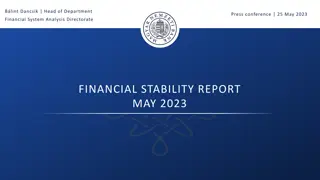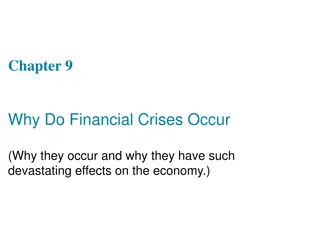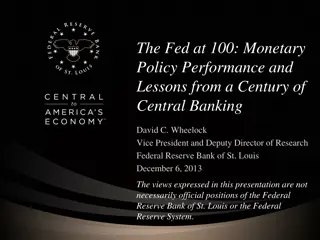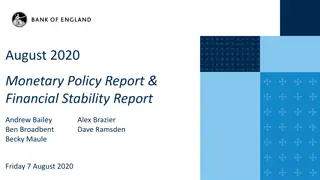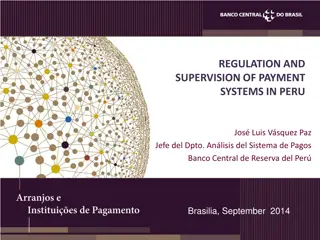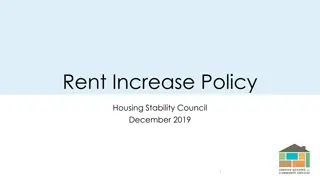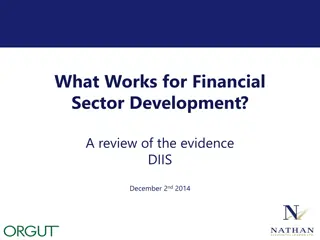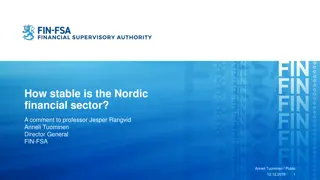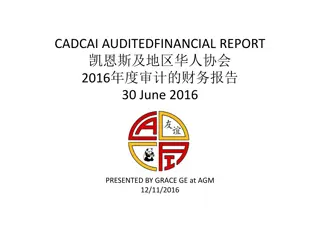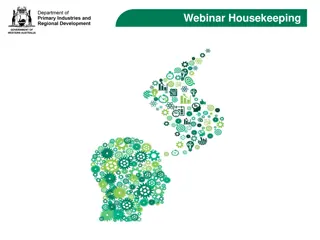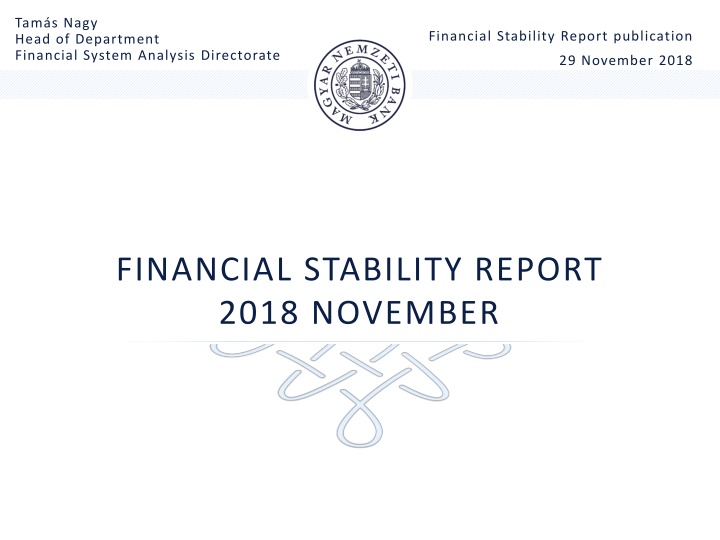
Financial Stability Report 2018: Insights and Trends
Explore the Financial Stability Report 2018 for valuable insights into the deepening financial system, emerging risks, and changes post the 10-year crisis. Discover the dynamic growth in corporate and household lending, strong shock absorbing capacity of the banking sector, and more.
Download Presentation

Please find below an Image/Link to download the presentation.
The content on the website is provided AS IS for your information and personal use only. It may not be sold, licensed, or shared on other websites without obtaining consent from the author. If you encounter any issues during the download, it is possible that the publisher has removed the file from their server.
You are allowed to download the files provided on this website for personal or commercial use, subject to the condition that they are used lawfully. All files are the property of their respective owners.
The content on the website is provided AS IS for your information and personal use only. It may not be sold, licensed, or shared on other websites without obtaining consent from the author.
E N D
Presentation Transcript
Tams Nagy Head of Department Financial System Analysis Directorate Financial Stability Report publication 29 November 2018 FINANCIAL STABILITY REPORT 2018 NOVEMBER
OVERALL PICTURE The deepening of the financial system and the favourable economic environment help outgrow the problems of the past. But behind these favourable trends, old and newly emerging risks can be discovered. 2 |
10 YEARS AFTER THE CRISIS: WHAT HAS CHANGED? 2008 2012 2018 Q2 Share of FX loans corporate 58% 55% 45% Share of FX loans households 67% 56% 1% Interest rate spread on corporate loans (HUF, small amount, newly disbursed) 2.7 percentage points 3.3 percentage points 3.0 percentage points Interest rate spread on housing loans to households 5.7 percentage points 4.0 percentage points 2.7 percentage points Corporate credit dynamics 6.5% -4.7% 12.3% Household credit dynamics 19.1% -9.8% 4.1% Return on Equity - ROE 11.3% -5.7% 15.0% Operational costs to assets 2.4% 2.2% 2.1% Share of loans more than 90 days overdue 4.6% 19.5% 4.1% Net NPL / regulatory capital 16% 40% 3.7% Banking system s capital adequacy ratio (consolidated in parentheses) 11.2% (12.9%) 15.8% (16.3%) 20.4% (17.2%) Loan-to-deposit ratio 152% 114% 73% 3 | Liquid assets / total assets 10% 17.4% 33.3%
10 YEARS AFTER THE CRISIS: WHAT HAS CHANGED? The shock absorbing capacity of the banking sector is strong: credit institutions are liquid and have strong capital adequacy. The profitability of credit institutions is high even in international comparison. The ratio of loans more than 90 days overdue is below 5 per cent, and the loan loss provision coverage is adequate. The foreign exchange denominated debt of economic agents with no natural hedging went through a conversion to HUF. Dynamic growth in both corporate and household lending. Improving lending structure: interest rate spread on new housing loans decreased, and new loans are characterised by longer interest rate fixation. 4 |
MAIN MESSAGES The international environment has become uncertain, but the CEE region proved to be resistant to capital outflow. The normalisation of the monetary conditions could hinder the debt sustainability of the economies. House prices rose further, the risks that real estates in Budapest are overvalued has increased. However, the price increase is not accompanied by risky lending, which limits stability risks. Corporate lending is experiencing a dynamic expansion, but the new loans are subject to interest rate risk. In the case of commercial real estate loans, MNB pays special attention to exchange rate risk. The interest rate structure of the newly disbursed housing loans went through a significant improvement. At the same time, the outstanding portfolio is mainly composed of variable interest rate loans. The profitability of the banking system is still outstanding, but the high profitability built on reversal of loan loss provisions seems to be fading out. Improving cost efficiency could increase profit in a sustainable way. 5 |
INTERNATIONAL MACROECONOMIC ENVIRONMENT MOUNTING RISKS AMIDST RISING YIELDS
GROWING RISKS, TIGHTENING INTEREST RATE ENVIRONMENT, REVERSING CAPITAL FLOWS per cent per cent 5 5 4 4 3 3 2 2 1 1 0 0 -1 -1 -2 -2 -3 -3 -4 -4 Emerging regions -5 -5 Developed countries 01-Jan-2018 - 18-Apr Emerging regions Africa Emerging Europe Latin America Middle East 01-Jan-2019 - 19-Sep Asia 19-Apr-2018 - 19-Sep CUMULATED BOND FLOWS AS A PERCENTAGE OF ASSETS UNDER MANAGEMENT IN 2018 Source | EPFR 7 |
THE EUROPEAN BANKS ARE STILL STRUGGLING WITH STRUCTURAL PROBLEMS 2.5% (0.6) 1.2% (1.7) 1.3% (3.4) 1.6% (0.3) 3.4% (0.4) LU: 0.8%; (1.3) MT: 3.8%; (0.5) SI: 8.5%; (1.5) 1.0% (10.6) 2.3% (13.1) 2.7% (0.6) 2.2% (38.2) 2.3% (17.0) 7.0% (14.0) 1.3% (48.4) 6.4% (8.7) 1.7% (46.4) 1.4% (1.8) 3.1% (1.2) 3.2% (14.8) 7.7% (3.4) 3.0% (132.6) 6.0% (1.7) 9.7% (159.0) 7.4% (1.0) 7.6% (2.7) 12.4% (29.8) 4.2% (98.9) 44.6% (94.3) 34.1% (13.2) RATIO AND VOLUME OF NON-PERFORMING LOANS IN EUROPE Note: Data for 2018 Q2; NPL ratio in per cent; in brackets the vol-ume of the non-performing loan portfolio in EUR billions. Green, yellow and red denote Member States with low, medium and high NPL ratios, respectively. 8 | Source | EBA
WHICH AFFECTS PRICING AS WELL 3.0 Yellow colour: CEE banks Purple colour: Turkish banks Grey colour: Greek banks Red colour: Italian banks 2.5 2.0 P/BV (2018 Q2) 1.5 1.0 0.5 0.0 -20 -10 0 10 20 Average ROE (2016 - 2018Q2) (per cent) LONG-TERM AVERAGE OF RETURN ON EQUITY AND MARKET VALUATION Source | SNL 9 |
REAL ESTATE MARKETS BUOYANT MARKET, WITH LATENT RISKS
THE RISK OF OVERVALUATION ROSE IN THE HOUSING MARKET OF BUDAPEST per cent per cent 40 40 30 30 20 20 10 10 0 0 -10 -10 -20 -20 -30 -30 -40 -40 Q4 Q4 Q4 Q4 Q4 Q4 Q4 Q4 Q4 Q4 Q4 Q4 Q4 Q4 Q4 Q4 Q4 2001 Q2 2003 Q2 2005 Q2 2006 Q2 2007 Q2 2008 Q2 2009 Q2 2010 Q2 2011 Q2 2012 Q2 2014 Q2 2016 Q2 2018 Q2 2002 Q2 2004 Q2 2013 Q2 2015 Q2 2017 Q2 Uncertainty of nationwide estimates Estimated deviation from the equillibrium house prices - average of estimates Estimated deviation from the equillibrium house prices in Budapest DEVIATION OF REAL HOUSE PRICES FROM THE ESTIMATED LEVEL JUSTIFIED BY FUNDAMENTALS, NATIONALLY AND IN BUDAPEST Note: The detailed assessment of housing market trends is available in the MNB s Housing Market Report November 2018. 11 | Source | MNB
WHICH IS NOT ACCOMPANIED BY THE EXPANSION OF OVERLY RISKY LENDING per cent per cent 15.0 100 13.5 90 12.0 80 10.5 70 9.0 60 7.5 50 6.0 40 4.5 30 3.0 20 1.5 10 0.0 0 95- 10-15 15-20 30-35 35-40 40-45 45-50 50-55 55-60 60-65 65-70 70-75 85-90 90-95 20-25 25-30 75-80 80-85 5-10 0-5 Loan-to-value ratio (LTV) Budapest Budapest (cumulated, RHS) Countryside Countryside (cumulated, RHS) DISTRIBUTION OF HOUSING LOANS DISBURSED IN THE PERIOD OF 2017 2018 Q2 BY LOAN-TO-VALUE RATIO Note: A loan-to-value ratio exceeding 80 per cent may exist in the case of loans exempted from the debt cap rules, taken out primarily for refinancing purposes. Volume-based distribution. Source | MNB 12 |
IN THE CASE OF COMMERCIAL REAL ESTATE LOANS WE PAY SPECIAL ATTENTION TO EXCHANGE RATE RISK apparent coverage EUR EUR Financing institution Customer Tenant Market EUR Loancontract HUF EUR EUR Customer Tenant Market EUR Property owner / debtor EUR EUR HUF Customer Tenant Market FXriskcategory EUR Nearlywithoutrisk HUF HUF Customer Tenant Low risk Market Mediumrisk Prices of services or goods High risk Rental contract Income of customer PARTICIPANTS OF COMMERCIAL REAL ESTATE FINANCING AND THEIR FX EXPOSURE Source | MNB 13 |
TRENDS IN LENDING DYNAMIC GROWTH IN PARALLEL WITH THE MANAGEMENT OF INTEREST RATE RISK
OUSTANDING CORPORATE LOANS EXPANDED DYNAMICALLY IN 2018 Q3 AS WELL per cent per cent 16 16 14 14 Total corporate sector: 13.9% SMEs (preliminary data): 13.5% 12 12 10 10 8 8 6 6 4 4 2 2 0 0 -2 -2 -4 -4 -6 -6 -8 -8 -10 -10 Q2 Q3 Q4 Q2 Q3 Q2 Q3 Q4 Q2 Q3 Q4 Q3 Q4 Q2 Q3 Q4 Q2 Q2 Q3 Q4 Q2 Q3 Q4 Q2 Q3 Q4 2010 Q1 2011 Q1 2013 Q1 2014 Q1 2015 Q1 2016 Q1 2017 Q1 2018 Q1 2012 Q1 Corporate sector (FIS, Year-on-year) SME sector (MFI, Year-on-year) SME sector with self-employed (MFI, Year-on-year) GROWTH RATE OF LOANS OUTSTANDING OF THE OVERALL CORPORATE SECTOR AND THE SME SECTOR Note: Transaction-based data, prior to 2015 Q4, data for SMEs are estimated based on banking sector data. Time-series data for the overall corporate sector for 2018 Q3 refers to loans vis- -vis the credit institutions sector. Figure for the SME sector for 2018 Q3 is based on preliminary data. 15 | Source | MNB
FGS FIX HELPS MANAGE INTEREST RATE RISKS FROM NEXT YEAR HUF Bn per cent 150 100 120 80 90 60 60 40 30 20 0 0 Q3 Q3 Q3 Q3 Q3 Q3 Q3 Q3 Q3 Q3 Q3 Q3 2015 Q1 2016 Q1 2017 Q1 2018 Q1 2015 Q1 2016 Q1 2017 Q1 2015 Q1 2016 Q1 2018 Q1 2018 Q1 2017 Q1 Up to 1 year 1 5 years More than 5 years Fixed interest rate Floating interest rate Ratio of fixed-rate loans (RHS) NEW SME FORINT LOANS BY INTEREST RATE FIXATION AND MATURITY Source | MNB 16 |
IN FOCUS: FINANCIAL PLANS OF MICRO AND SMALL BUSINESSES 0% 5% 10% 15% 20% 25% 30% 35% Too high administrative need 1% Expected rejection 2% Currently repaying another loan 2% Too tight lending standards 2% Lack of collateral 3% Uncertainty about the company's future 4% Does not want to borrow 4% Poor profitability 4% Does not trust in banks/loans 4% Too high interest rates 6% Does not plan any investment 9% Does not need 25% Want to involve other type of financing 31% 0% 5% 10% 15% 20% 25% 30% 35% THE REASON FOR THE LACK OF A BORROWING PLAN Note: Based on answers of 849 companies. 17 | Source | MNB
THE VOLUME OF NEWLY DISBURSED HOUSEHOLD LOANS INCREASED AS WELL HUF Bn HUF Bn 700 700 Growth rate Y-o-Y (Q3) 600 600 500 500 Outstanding household loans: 5% 400 400 300 300 200 200 Housing loans new contracts: 39% 100 100 0 0 Q3 Q3 Q3 Q3 Q3 Q3 Q3 Q3 Q3 Q3 Q3 Q3 Q3 Q3 2005 Q1 2007 Q1 2008 Q1 2009 Q1 2010 Q1 2011 Q1 2012 Q1 2013 Q1 2014 Q1 2016 Q1 2017 Q1 2018 Q1 2006 Q1 2015 Q1 Personal loans new contracts: 49% Housing loans Consumer loans Loan refinancing Sole proprietors FGS 4-quarter average NEW HOUSEHOLD LOANS IN THE CREDIT INSTITUTIONS SECTOR Source | MNB 18 |
PRICING: FAVOURABLE TRENDS CONCERNING THE SPREADS ON FIXED RATE HOUSING LOANS percentage point percentage point 8 8 7 7 6 6 5 5 4 4 3 3 2 2 1 1 0 0 Q2 Q3 Q2 Q4 Q3 Q4 Q2 Q3 Q4 Q2 Q3 Q2 Q4 Q2 Q3 Q4 Q3 Q2 Q4 Q3 2012 Q1 2013 Q1 2014 Q1 2015 Q1 2016 Q1 2017 Q1 2018 Q1 Housing loans - 1-5 year fixation Housing loans - variable rate Housing loans - over 5 year fixation INTEREST RATE SPREADS ON NEW HOUSING LOANS TO HOUSEHOLDS Note: In the case of variable-rate housing loans or ones with up to 1-year rate fixation, APR-based smoothed spread over the 3-month BUBOR, while in the case of housing loans fixed for a period longer than one year, the APR-based smoothed spread over the corresponding IRS. For personal loans, APR-based smoothed spread over the 3-month BUBOR. 19 | Source | MNB
NEW DISBURSEMENT: THE SHARE OF HOUSING LOANS WITH OVER 1 YEAR FIXATION IS ABOVE 80 PER CENT HUF Bn per cent 120 100 100 85 80 70 60 55 40 40 20 25 0 10 2017Q4 2018Q1 2018Q2 2018Q3 Certified Consumer-friendly Housing Loan disbursement Rate of CCFHL products to housing loans with fixed interest rate (RHS) Rate of fixed interest rate loans to total housing loan disbursment (RHS) HOUSING LOANS BY INTEREST RATE FIXATION AND THE PROPORTION OF CERTIFIED CONSUMER-FRIENDLY HOUSING LOANS Note: The ratio of the certified consumer-friendly housing loans shows the share within the housing loans with an interest period longer than 3 years. 20 | Source | MNB
INTEREST RATE FIXATION STRUCTURE: OUSTANDING STOCK AND NEW DISBURSEMENT Outstanding mortgage loans (September 2018) New contracts (2018 Q3) 4.2% 7.8% 13.1% 12.5% 37.2% 22.7% 60.5% 41.9% Up to 1 year interest rate fixation Interest rate fixation between 5-10 years Interest rate fixation between 1-5 years Interest rate fixation over 10 years DISTRIBUTION OF NEWLY DISBURSED MORTGAGES AND OUSTANDING STOCK BY INTEREST RATE FIXATION 21 | Source | MNB
LOANS OUTSTANDING: THE SHARE OF FIX RATE LOANS COULD GROW GRADUALLY, BUT THERE IS STILL WORK TO BE DONE HUF Bn per cent 9 000 90 8 000 80 7 000 70 6 000 60 5 000 50 4 000 40 3 000 30 2 000 20 1 000 10 0 0 2030 2018 2019 2020 2021 2022 2023 2024 2025 2026 2027 2028 2029 Over 10 years interest rate fixation 5-10 year interest rate fixation 1-5 year interest rate fixation Variable rate Share of housing loans with over 1 year fixation (RHS) TECHNICAL PROJECTION OF OUTSTANDING MORTGAGE LOANS BY INTEREST TYPE Note: The chart shows the technical projection of the outstanding loan structure ceteris paribus, and is not considered as a forecast. The projection with regard to the longer interest rate periods may be regarded as a lower estimate, bearing in mind that the debt cap rules amended in October will increasingly divert demand to loans with longer interest rate fixation. Source | MNB 22 |
WHAT COULD DEBTORS AND BANKS DO? DEBTORS HAVING FX CONVERTED LOAN should assess their opportunities, ask their creditor or other banks about the conditions of obtaining a fixed rate contract since some of the outstanding stock is characterised by long residual maturity and high credit costs, debtors may refinance their obligations with cheap and secure loans such as the Certified Consumer-friendly Housing Loan; and thus, hedging against interest rate risk. CREDIT INSTITUTIONS should asseshow many of their debtors would gain from replacing their variable rate loans to fixed rate financing. MNB welcomes if banks proactively inform these debtors about the refinancing offers, it is mainly relevant in case of those debtors whose residual maturity is long, and thus a potential rise in interest rate would hit them harder. 23 |
PORTFOLIO QUALITY CLEANING CONTINUED IN 2018, BUT THERE ARE STILL NON-PERFORMING PORTFOLIOS TO BE REDUCED
CORPORATE LOANS: THE GROWTH OF LOANS OUTSTANDING HELPS OUTGROW THE REMAINING NON-PERFORMING LOANS percentage point percentage point 4 4 Share of non- performing corporate loans: 6.3% 3 3 2 2 1 1 0 0 -1 -1 -2 -2 Share of corporate loans with 90+ days past due: 3% -3 -3 MKB bank reorganization and portfolio sale -4 -4 -5 -5 Q2 Q3 Q4 Q2 Q3 Q4 Q2 Q2 Q3 Q4 Q2 Q3 Q4 Q4 Q2 Q3 Q4 Q2 Q3 Q4 Q2 Q3 2012 Q1 2013 Q1 2014 Q1 2015 Q1 2016 Q1 2017 Q1 2018 Q1 2011 Q1 Portfolio impairment / improvement and reclassification (NPL but less than 90 days overdue) Portfolio impairment / improvement and reclassification component Portfolio cleaning component Stock component Change in NPL ratio Change in the ratio of 90 days overdue loans FACTORS AFFECTING CHANGES IN THE RATIO OF NON-PERFORMING CORPORATE LOANS Source | MNB 25 |
HOUSEHOLD LOANS: THE SHARE OF NON- PERFORMING LOANS IS LESS THAN 10 PER CENT per cent HUF Bn 25.0 1 500 Share of non- performing household loans: 8.4% 22.5 1 350 20.0 1 200 17.5 1 050 15.0 900 12.5 750 10.0 600 Share of household loans with 90+ days past due: 5.9% 7.5 450 5.0 300 2.5 150 0.0 0 Q4 Q4 Q2 Q4 Q4 Q4 Q4 Q4 Q4 Q4 Q4 Q4 Q4 Q4 2004 Q2 2005 Q2 2006 Q2 2007 Q2 2008 Q4 2009 Q2 2010 Q2 2012 Q2 2014 Q2 2016 Q2 2017 Q2 2018 Q2 2011 Q2 2013 Q2 2015 Q2 Non-performing loans with not more than 90 days past due (RHS) Household loans with 90+ days past due (RHS) Ratio of household loans 31-90 days past due Ratio of household loans with 90+ days past due Non-performing household loan ratio STOCK AND RATIO OF NON-PERFORMING HOUSEHOLD LOANS OF CREDIT INSTITUTIONS BY CONTRACTS Source | MNB 26 |
IN FOCUS: WHAT HAPPENS WITH THE CLAIMS AT THE DEBT MANAGEMENT COMPANIES? 0% 20% 40% 60% 80% 100% Beyond 5 years (55.8% of the transactions) Between 2-5 years (23.5% of the transactions) Between 1-2 years (15.9% of the transactions) Within a year (4.9% of the transactions) 0% 20% 40% 60% 80% 100% Debt restructuring Debt relief and lump-sum repayment Settlement after sale of property Sale to NET Debt settlement procedure SHARE OF THE DEBT MANAGEMENT COMPANIES' AGREEMENT METHODS BY OLDEST ARREARS CATEGORIES (NUMBER OF TRANSACTIONS) Source | MNB 27 |
INCOME AND CAPITAL POSITION THE PROFIT EFFECT OF REVERSALS OF PROVISIONS SEEMS TO BE WEARING OFF
MODERATE DECREASE IN PROFITS, MAINLY DUE TO THE LOWER AMOUNT OF REVERSALS 0 50 100 150 200 250 300 350 400 450 HUF Bn Income - 2017 Q2 364 Provisioning -50% -44 Costs -7% -24 Interest income -16 -4% -14% -14 Dividends 2% 1 Other 4% Bank levy 2 4 Fee income 2% Financial operations 40% 26 Income - 2018 Q2 -18% 300 HUF Bn 0 50 100 150 200 250 300 350 400 450 CHANGE IN THE MAIN INCOME COMPONENTS BETWEEN JUNE 2017 AND 2018 Source | MNB 29 |
THE LEVEL OF COST TO ASSETS DECREASED, BUT THERE IS ROOM FOR FURTHER IMPROVEMENT 100 SE DK The Banking digitalisation sub-pillar of the MNB NL 90 FI UK Banking System Competitiveness Index 80 PT EE 70 IE AT CY LU BEDE 60 (2014-2016) LV CZ 50 PL SI MT SK LT 40 IT ES HR FR HU* HU 30 20 GR BG 10 RO 0 0.0 0.5 Operating expenses / Total assets (2017, per cent) 1.0 1.5 2.0 2.5 3.0 3.5 THE RELATIONSHIP BETWEEN COST-TO-ASSETS AND BANK DIGITALISATION Note: The operating costs-to-assets ratio is based on consolidated data, HU* is adjusted for one-off effects (foreign subsidiaries, state levies). The MNB BSCI Banking digitalisation sub-pillar includes the following indicators: the share of individuals using internet for banking and the share of individuals using digital payment, mobile payment and online payment. 30 | Source | MNB, ECB CBD, Eurostat, WB
BANK STRESS TESTS BANKS WOULD REMAIN LIQUID AND HAVE STRONG CAPITAL ADEQUACY AFTER A NEGATIVE SHOCK
ONLY A FEW INSTITUTIONS WOULD FALL UNDER THE LCR LIMIT EVEN IN CASE OF A MASSIVE NEGATIVE SHOCK HUF Bn per cent 2 500 50 2 000 40 1 500 30 1 000 20 500 10 0 0 -500 -10 Q2 Q3 Q4 Q4 Q2 Q2 Q3 2015 Q4 2016 Q1 2017 Q1 2018 Q1 Liquidity need to meet the regulatory requirement Liquidity buffer above the regulatory requirement Liquidity Stress Index (RHS) LIQUIDITY STRESS INDEX Note: The indicator is the sum of the liquidity shortfalls in percentage points (but maximum 100 percentage points) compared to the 100 per cent regulatory limit of the LCR, weighted by the balance sheet total in the stress scenario. The higher the value of the indicator, the greater the liquidity risk. The periods for which the test is performed on an enlarged institutional base are marked by a blue band. Source | MNB 32 |
WHILE ALL THE BANKS WOULD COMPLY WITH THE CAPITAL ADEQUACY RULES Baseline scenario Stress scenario End of first year End of second year End of first year End of second year Capital need of banks (HUF Bn) Capital buffer of banks above requirement (HUF Bn) Capital need of banks (HUF Bn) Capital buffer of banks above requirement (HUF Bn) 0 0 0 0 8 per cent capital requirements 2 253 2 790 1 956 2 303 0 0 0 0 10.5 per cent capital requirements 1 860 2 394 1 557 1 901 STRESS TEST RESULTS WITH 8 AND 10.5 PER CENT CAPITAL REQUIREMENT Source | MNB 33 |
MAIN MESSAGES The international environment has become uncertain, but the CEE region proved to be resistant to capital outflow. The normalisation of the monetary conditions could hinder the debt sustainability of the economies. House prices rose further, the risks that real estates in Budapest are overvalued has increased. However, the price increase is not accompanied by risky lending, which limits stability risks. Corporate lending is experiencing a dynamic expansion, but the new loans are subject to interest rate risk. In the case of commercial real estate loans, MNB pays special attention to exchange rate risk. The interest rate structure of the newly disbursed housing loans went through a significant improvement. At the same time, the outstanding portfolio is mainly composed of variable interest rate loans. The profitability of the banking system is still outstanding, but the high profitability built on reversal of loan loss provisions seems to be fading out. Improving cost efficiency could increase profit in a sustainable way. 34 |
Thank you for your attention! 35 |

